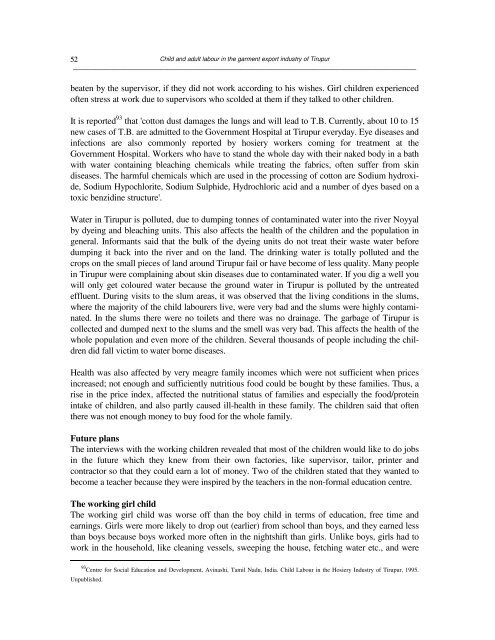Create successful ePaper yourself
Turn your PDF publications into a flip-book with our unique Google optimized e-Paper software.
52<br />
<strong>Child</strong> <strong>and</strong> <strong>adult</strong> <strong>labour</strong> <strong>in</strong> <strong>the</strong> <strong>garment</strong> <strong>export</strong> <strong>in</strong>dustry <strong>of</strong> Tirupur<br />
──────────────────────────────────────────────────────────────────────────────────────────────<br />
beaten by <strong>the</strong> supervisor, if <strong>the</strong>y did not work accord<strong>in</strong>g to his wishes. Girl children experienced<br />
<strong>of</strong>ten stress at work due to supervisors who scolded at <strong>the</strong>m if <strong>the</strong>y talked to o<strong>the</strong>r children.<br />
It is reported 93 that 'cotton dust damages <strong>the</strong> lungs <strong>and</strong> will lead to T.B. Currently, about 10 to 15<br />
new cases <strong>of</strong> T.B. are admitted to <strong>the</strong> Government Hospital at Tirupur everyday. Eye diseases <strong>and</strong><br />
<strong>in</strong>fections are also commonly reported by hosiery workers com<strong>in</strong>g for treatment at <strong>the</strong><br />
Government Hospital. Workers who have to st<strong>and</strong> <strong>the</strong> whole day with <strong>the</strong>ir naked body <strong>in</strong> a bath<br />
with water conta<strong>in</strong><strong>in</strong>g bleach<strong>in</strong>g chemicals while treat<strong>in</strong>g <strong>the</strong> fabrics, <strong>of</strong>ten suffer from sk<strong>in</strong><br />
diseases. The harmful chemicals which are used <strong>in</strong> <strong>the</strong> process<strong>in</strong>g <strong>of</strong> cotton are Sodium hydroxide,<br />
Sodium Hypochlorite, Sodium Sulphide, Hydrochloric acid <strong>and</strong> a number <strong>of</strong> dyes based on a<br />
toxic benzid<strong>in</strong>e structure'.<br />
Water <strong>in</strong> Tirupur is polluted, due to dump<strong>in</strong>g tonnes <strong>of</strong> contam<strong>in</strong>ated water <strong>in</strong>to <strong>the</strong> river Noyyal<br />
by dye<strong>in</strong>g <strong>and</strong> bleach<strong>in</strong>g units. This also affects <strong>the</strong> health <strong>of</strong> <strong>the</strong> children <strong>and</strong> <strong>the</strong> population <strong>in</strong><br />
general. Informants said that <strong>the</strong> bulk <strong>of</strong> <strong>the</strong> dye<strong>in</strong>g units do not treat <strong>the</strong>ir waste water before<br />
dump<strong>in</strong>g it back <strong>in</strong>to <strong>the</strong> river <strong>and</strong> on <strong>the</strong> l<strong>and</strong>. The dr<strong>in</strong>k<strong>in</strong>g water is totally polluted <strong>and</strong> <strong>the</strong><br />
crops on <strong>the</strong> small pieces <strong>of</strong> l<strong>and</strong> around Tirupur fail or have become <strong>of</strong> less quality. Many people<br />
<strong>in</strong> Tirupur were compla<strong>in</strong><strong>in</strong>g about sk<strong>in</strong> diseases due to contam<strong>in</strong>ated water. If you dig a well you<br />
will only get coloured water because <strong>the</strong> ground water <strong>in</strong> Tirupur is polluted by <strong>the</strong> untreated<br />
effluent. Dur<strong>in</strong>g visits to <strong>the</strong> slum areas, it was observed that <strong>the</strong> liv<strong>in</strong>g conditions <strong>in</strong> <strong>the</strong> slums,<br />
where <strong>the</strong> majority <strong>of</strong> <strong>the</strong> child <strong>labour</strong>ers live, were very bad <strong>and</strong> <strong>the</strong> slums were highly contam<strong>in</strong>ated.<br />
In <strong>the</strong> slums <strong>the</strong>re were no toilets <strong>and</strong> <strong>the</strong>re was no dra<strong>in</strong>age. The garbage <strong>of</strong> Tirupur is<br />
collected <strong>and</strong> dumped next to <strong>the</strong> slums <strong>and</strong> <strong>the</strong> smell was very bad. This affects <strong>the</strong> health <strong>of</strong> <strong>the</strong><br />
whole population <strong>and</strong> even more <strong>of</strong> <strong>the</strong> children. Several thous<strong>and</strong>s <strong>of</strong> people <strong>in</strong>clud<strong>in</strong>g <strong>the</strong> children<br />
did fall victim to water borne diseases.<br />
Health was also affected by very meagre family <strong>in</strong>comes which were not sufficient when prices<br />
<strong>in</strong>creased; not enough <strong>and</strong> sufficiently nutritious food could be bought by <strong>the</strong>se families. Thus, a<br />
rise <strong>in</strong> <strong>the</strong> price <strong>in</strong>dex, affected <strong>the</strong> nutritional status <strong>of</strong> families <strong>and</strong> especially <strong>the</strong> food/prote<strong>in</strong><br />
<strong>in</strong>take <strong>of</strong> children, <strong>and</strong> also partly caused ill-health <strong>in</strong> <strong>the</strong>se family. The children said that <strong>of</strong>ten<br />
<strong>the</strong>re was not enough money to buy food for <strong>the</strong> whole family.<br />
Future plans<br />
The <strong>in</strong>terviews with <strong>the</strong> work<strong>in</strong>g children revealed that most <strong>of</strong> <strong>the</strong> children would like to do jobs<br />
<strong>in</strong> <strong>the</strong> future which <strong>the</strong>y knew from <strong>the</strong>ir own factories, like supervisor, tailor, pr<strong>in</strong>ter <strong>and</strong><br />
contractor so that <strong>the</strong>y could earn a lot <strong>of</strong> money. Two <strong>of</strong> <strong>the</strong> children stated that <strong>the</strong>y wanted to<br />
become a teacher because <strong>the</strong>y were <strong>in</strong>spired by <strong>the</strong> teachers <strong>in</strong> <strong>the</strong> non-formal education centre.<br />
The work<strong>in</strong>g girl child<br />
The work<strong>in</strong>g girl child was worse <strong>of</strong>f than <strong>the</strong> boy child <strong>in</strong> terms <strong>of</strong> education, free time <strong>and</strong><br />
earn<strong>in</strong>gs. Girls were more likely to drop out (earlier) from school than boys, <strong>and</strong> <strong>the</strong>y earned less<br />
than boys because boys worked more <strong>of</strong>ten <strong>in</strong> <strong>the</strong> nightshift than girls. Unlike boys, girls had to<br />
work <strong>in</strong> <strong>the</strong> household, like clean<strong>in</strong>g vessels, sweep<strong>in</strong>g <strong>the</strong> house, fetch<strong>in</strong>g water etc., <strong>and</strong> were<br />
93 Centre for Social Education <strong>and</strong> Development, Av<strong>in</strong>ashi, Tamil Nadu, <strong>India</strong>. <strong>Child</strong> Labour <strong>in</strong> <strong>the</strong> Hosiery Industry <strong>of</strong> Tirupur, 1995.<br />
Unpublished.


















